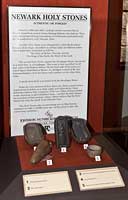
|
|
Download Options
| Image Name | Width x Height | Size |
|---|---|---|
| SIA3981.jpg | 427 x 640 | 68K |
| SIA3981.jpg | 800 x 1200 | 226K |
| SIA3981.jpg | 3744 x 5617 | 3M |
Caption
The "Newark Holy Stones" are on display in the Johnson-Humrickhouse Museum in Roscoe Village, 300 Whitewoman St., Coshocton, Ohio. This photo shows the display and the caption reads:
Authentic or Forged?
Between 1860 and 1867, Licking County surveyor David Wyrick unearthed several stones bearing Hebrew inscriptions. They were discovered during excavations of earthworks associated with the Moundbuilders near Newark, Ohio.
The first Holy Stone was subsequently called the Keystone because of its shape. Inscribed on all four sides are Hebrew letters which have been translated as follows:
The King of the Earth, the Word of the Lord.
The second Holy Stone, named the Decalogue Stone, was found in a stone box, or sarcophagus. This stone is also inscribed on all four sides with Hebrew letters. On the front side of the stone is a robed figure identified as Moses. An abridged version of the Ten Commandments circle the figure and continue on the other three sides.
A small stone bowl was found with the Decalogue Stone.
From the very moment of their discovery, these curious stones inspired much debate as to their origin and authenticity. Some historians believe that a fragment of the Lost Tribes of Israel settled in the Americas in pre-Columbian times, and that the Holy Stones are a product of this ancient culture. Others believe that the Holy Stones are only the result of an elaborate hoax.
The Holy Stones play an interesting role in Ohio history, whether it be 100 or 10,000 years ago. At this point in time, the controversy continues...